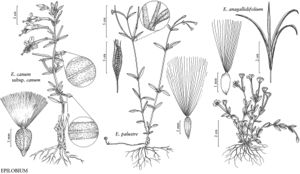Epilobium canum subsp. canum
Herbs suffruticose or not. Stems 20–110 (–120) cm, ± densely strigillose, densely villous, or both, often mixed short glandular puberulent especially distally, sometimes predominantly short glandular puberulent, rarely glabrate. Leaves alternate and often fasciculate distally; blade usually green to grayish green, rarely silvery-canescent, usually narrowly linear to narrowly lanceolate or elliptic, rarely to narrowly ovate, 0.6–4.5 × 0.1–0.6 (–0.8) cm, margins subentire to remotely serrulate, 4–10 teeth per side, veins usually inconspicuous, surfaces usually moderately to densely villous and/or strigillose, rarely glabrate. Flowers: floral-tube 17–29 mm; sepals 7–10 mm; petals 8–15 mm. Capsules 18–30 mm; subsessile or pedicel 1–3 mm. Seeds 1.5–2.2 × 0.9–1.2 mm. 2n = 30, 60.
Phenology: Flowering (Apr–)Jun–Dec.
Habitat: Dry rocky or stony slopes and ridges, disturbed chaparral, along coastal bluffs, offshore islands, scattered in Sierra Nevada foothills.
Elevation: 0–1000(–2700) m.
Distribution
Calif., Mexico (Baja California)
Discussion
The extremely variable subsp. canum has the lowest elevational range, from sea level to 1000 m through most of its range, and to 2700 m in a few places in the southern Sierra Nevada. It occurs almost exclusively in the Californian Province as defined by R. F. Thorne (1993d), and in the Great Central Valley, Central Western California, and Southwestern California subdivisions of the Jepson Manual (B. G. Baldwinet al. 2012). Specifically, it occurs from north-central California (Lake, Sonoma, and Yolo counties) through the Coast Ranges and along the Pacific Coast south to Baja California, extending to the foothills of the Sierra Nevada (Fresno, Tulare, and Tuolumne counties), with one questionably native disjunct locality in Humboldt County.
In areas where subsp. canum overlaps in range with subsp. latifolium, especially in mountainous areas of southern California (notably Kern, Los Angeles, Monterey, Riverside, and San Bernardino counties), specimens of intermediate morphology occur. Most populations of subsp. canum occur at lower elevations, but where the taxa are sympatric, intermediates can be found. Some specimens from the New York, Panamint, and other mountain ranges in the Mojave Desert of San Bernardino County, which extend into Arizona, are treated here as subsp. latifolium, but these have leaves somewhat narrower than typical for that subspecies and approach those of subsp. canum.
Distinctive populations of subsp. canum, consistingof large, shrubby, densely pubescent plants with relatively narrow, fascicled leaves, occur particularly near the coast in southern California. Farther inland and at higher elevations, populations with variable combinations of characters led to a proliferation of names. Although some local series of populations appear quite distinctive, over the entire range there are no combinations of characters that consistently delimit morphological units, nor do any patterns differentiate diploids from tetraploids.
Selected References
None.
Lower Taxa
"narrower" is not a number.
